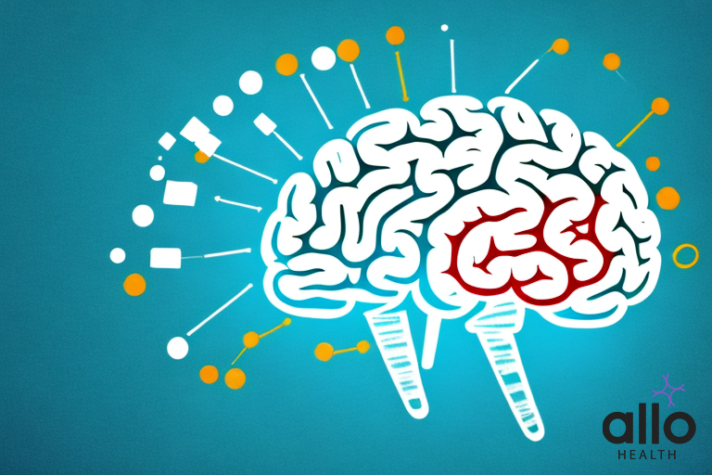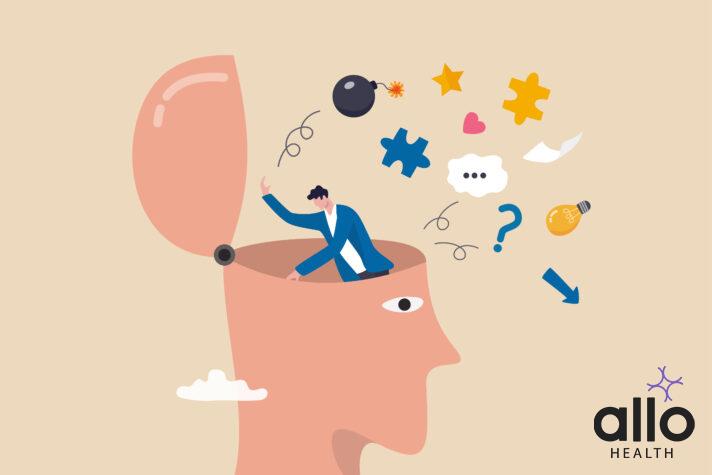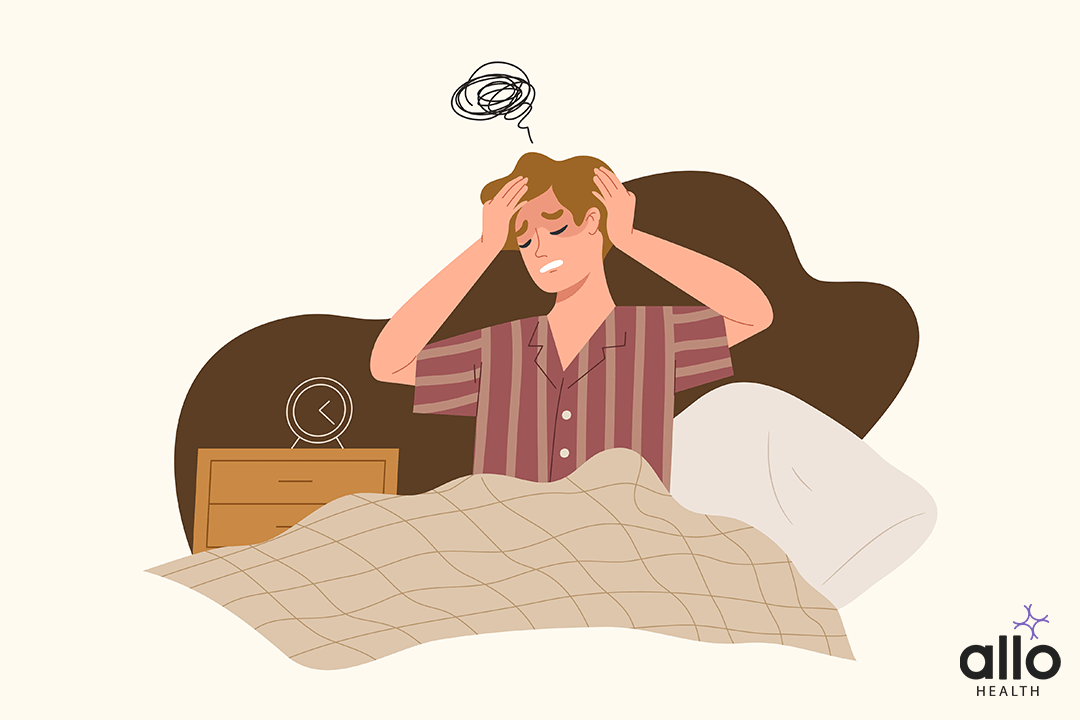The Link Between Pornography And Dopamine

Allo Health is dedicated to personalized well-being, offering support and trusted information tailored to individual health goals. The platform emphasizes human-generated content, led by a distinguished medical team of experts, including physicians and sexual health specialists. Their commitment to credibility involves rigorous fact-checking, authoritative research, and continuous updates to ensure accurate, up-to-date information. Allo Health's unique approach goes beyond conventional platforms, providing expert-led insights and a continuous commitment to excellence, with user feedback playing a crucial role in shaping the platform's authoritative voice.

Dr. Aditi completed her undergraduate medical education at AJIMS, Mangalore, after which she worked in multi-speciality hospitals with COVID patients and in the Pain and Palliative medicine department. Driven by her experiences, she developed a keen interest in psychiatry. Dr. Aditi believes that mental health is just as, if not more important, than physical health.
Why This Was Upated?
Our experts continually monitor the health and wellness space, and we update our articles when new information became available.
Updated on 20 June, 2024
- Article was updated as part of our commitment to diversity, equity, and inclusion.

"The following blog article provides general information and insights on various topics. However, it is important to note that the information presented is not intended as professional advice in any specific field or area. The content of this blog is for general educational and informational purposes only.
Book consultation
The content should not be interpreted as endorsement, recommendation, or guarantee of any product, service, or information mentioned. Readers are solely responsible for the decisions and actions they take based on the information provided in this blog. It is essential to exercise individual judgment, critical thinking, and personal responsibility when applying or implementing any information or suggestions discussed in the blog."
Pornography has long been a controversial topic, with some arguing that it promotes sexual liberation while others fear its impact on individuals and society as a whole. Recently, there has been a growing body of research on the effect of pornography on the brain’s reward system, specifically the role of dopamine. In this article, we will explore the link between pornography and dopamine, the neuroscience of porn addiction, and the negative effects of excessive pornography consumption on dopamine levels.
The Advantages And Disadvantages Of Pornography
Discussing the advantages and disadvantages of pornography is a complex and controversial topic, as opinions on this matter can vary widely. It’s essential to approach the subject with sensitivity and recognize that individual perspectives may differ. Here’s an overview of some commonly mentioned advantages and disadvantages associated with pornography:
Advantages:
- Entertainment and Fantasy: Some argue that pornography serves as a form of entertainment and fantasy, providing a means for adults to explore and enjoy sexual fantasies in a safe and consensual manner.
- Sexual Education: Supporters claim that pornography can offer a source of sexual education for adults, helping them understand diverse sexual preferences and practices.
- Stress Relief: Like other forms of entertainment, pornography may be seen as a way to relieve stress or provide an escape from daily pressures for some individuals.
- Artistic Expression: Some forms of adult content are considered a form of artistic expression, exploring themes related to human sexuality, relationships, and emotions.
- Freedom of Expression: Advocates for freedom of expression argue that consenting adults have the right to produce and consume pornography as a form of protected speech.
- Exploitation and Coercion: One of the primary concerns is the potential for exploitation, as there are instances of individuals being coerced or forced into the pornography industry against their will.
- Objectification: Critics argue that pornography can contribute to the objectification of individuals, reducing them to sexual objects and perpetuating harmful stereotypes.
- Impact on Relationships: Excessive consumption of pornography may lead to unrealistic expectations in relationships, causing dissatisfaction and, in some cases, contributing to relationship concerns.
- Addiction and Escalation: Some individuals may develop an addiction to pornography, leading to negative consequences such as reduced productivity, relationship concerns, or the escalation to more extreme and potentially harmful content.
- Ethical Concerns: The production and distribution of pornography raise ethical concerns, especially regarding the age and consent of the participants, as well as the potential for the content to be non-consensually shared online.
- Impact on Mental Health: There are debates about the potential impact of pornography on mental health, with some studies suggesting a link between excessive consumption and negative outcomes such as anxiety, depression, and body image concerns.
It’s important to note that attitudes toward pornography can be influenced by cultural, religious, and individual beliefs. Moreover, the impact of pornography can vary widely among individuals, and research on this topic continues to evolve. It’s crucial to consider diverse perspectives and engage in open, respectful discussions to better understand the complexities surrounding this concern.
The Link Between Pornography and Dopamine

The link between pornography and dopamine involves the brain’s reward system, a complex network of neurotransmitters and receptors that play a crucial role in motivating behavior and reinforcing certain activities. Dopamine is a neurotransmitter that is particularly associated with the brain’s reward system and plays a key role in pleasure, motivation, and reinforcement. Here’s a detailed explanation of the connection between pornography and dopamine:
- Dopamine and the Brain’s Reward System: The brain’s reward system is designed to reinforce behaviors that contribute to survival and reproduction. When we engage in activities that are pleasurable or beneficial for our well-being, the brain releases dopamine as a way to encourage us to repeat those behaviors.
- Dopamine Release and Pleasure: Dopamine is often referred to as the “feel-good” neurotransmitter because it is associated with feelings of pleasure and reward. When we experience something pleasurable, including sexual arousal, the brain releases dopamine in certain areas, reinforcing the desire to engage in the activity again.
- Pornography and Dopamine Release: Watching pornography, particularly explicit and sexually stimulating content, can trigger the release of dopamine in the brain. The visual and sexual stimuli present in pornography activate the brain’s reward system, leading to the experience of pleasure and arousal.
- Role of Novelty: Dopamine release is also influenced by novelty. The brain tends to respond more strongly to novel stimuli, and pornography often provides a variety of novel and visually stimulating content. This can lead to an increased release of dopamine compared to familiar or routine stimuli.
- Impact on Dopamine Sensitivity: Some research suggests that frequent exposure to highly stimulating activities, such as pornography, may lead to desensitization of the brain’s reward system. Over time, individuals may require more intense or novel stimuli to achieve the same level of dopamine release, potentially contributing to a cycle of escalating consumption.
- Addiction and Dopamine Dysregulation: In some cases, individuals may develop problematic patterns of pornography consumption that resemble behavioral addictions. This is often associated with changes in dopamine regulation and sensitivity, similar to what is observed in substance abuse.
- Withdrawal Symptoms: For individuals who exhibit signs of addiction to pornography, there may be withdrawal symptoms when they attempt to reduce or stop consumption. These symptoms can include anxiety, irritability, and cravings, which are linked to changes in dopamine levels and the brain’s adaptation to the addictive behavior.
- Individual Differences: It’s important to note that individual responses to pornography and dopamine release can vary. Factors such as genetics, personal experiences, and overall mental health can influence how an individual’s brain responds to sexual stimuli and the subsequent release of dopamine.
While there is evidence suggesting a link between pornography consumption and dopamine release, it’s crucial to approach this topic with nuance. Not everyone who views pornography will experience negative consequences, and research on the subject is ongoing. Additionally, the term “pornography addiction” is a subject of debate within the scientific community, with some experts questioning its classification as a formal addiction.
Parts Of The Brain Negatively Affected By Pornography
The impact of pornography on the brain is a subject of ongoing research, and it’s important to note that individual responses can vary. While some studies suggest potential negative effects, it’s essential to approach this topic with nuance. Here’s a discussion of some parts of the brain that have been associated with potential negative effects related to pornography:
- Prefrontal Cortex: The prefrontal cortex, responsible for decision-making, impulse control, and judgment, is often mentioned in discussions about the potential negative effects of pornography. Some studies propose that excessive pornography consumption may be linked to alterations in prefrontal cortex activity, potentially affecting decision-making and impulse control.
- Striatum: The striatum is a region involved in reward processing and habit formation. Pornography, particularly due to its association with dopamine release, may impact the striatum. Overstimulation of this region can potentially contribute to habituation and the development of patterns resembling addiction.
- Amygdala: The amygdala is associated with emotional processing, including the experience of pleasure and arousal. Some studies suggest that frequent exposure to sexually explicit material might influence the amygdala, potentially leading to changes in emotional responses and sensitivity to sexual stimuli.
- Hippocampus: The hippocampus, crucial for memory formation and retrieval, has also been studied in the context of pornography consumption. Some research indicates that excessive exposure may affect the structure and function of the hippocampus, potentially influencing memory processes related to sexual experiences.
- Nucleus Accumbens: The nucleus accumbens is a key component of the brain’s reward system. Pornography’s association with dopamine release can influence the activity of the nucleus accumbens, potentially contributing to the reinforcement of behaviors and the development of compulsive patterns.
- Frontal Cortex: The frontal cortex, which includes the prefrontal cortex, is involved in executive functions such as planning and self-control. Some studies propose that pornography consumption might impact the frontal cortex, potentially affecting cognitive functions related to self-regulation.
It’s crucial to emphasize that research on this topic is complex, and not all studies agree on the extent or nature of these potential effects. Additionally, individual factors, such as age, frequency of consumption, and pre-existing conditions, can influence how the brain responds to pornography. Further research is needed to better understand the nuances of the relationship between pornography and the brain.
Can Pornography Cause Sexual Dysfunction Or Sexual Disorders

The relationship between pornography consumption and sexual dysfunction or disorders is a complex and debated topic. While some studies suggest potential associations, it’s crucial to approach this subject with nuance and recognize individual variations. Here’s a detailed exploration of the potential links:
- Correlation vs. Causation: Research has identified correlations between high pornography consumption and sexual difficulties, but establishing a direct cause-and-effect relationship is challenging. Various factors, such as pre-existing sexual concerns, relationship dynamics, and mental health, can contribute to both increased pornography use and sexual dysfunction.
- Pornography-Induced Erectile Dysfunction (PIED): Some anecdotal reports describe a phenomenon known as Pornography-Induced Erectile Dysfunction (PIED), where individuals attribute their difficulties in achieving or maintaining an erection to extensive pornography consumption. But, the scientific evidence supporting PIED is limited, and other factors like anxiety or relationship concerns may also play a role.
- Desensitization and Hyperstimulation: The argument that extensive exposure to explicit sexual content can lead to desensitization and reduced responsiveness to real-life sexual stimuli is debated. Some propose that individuals who regularly consume pornography may develop unrealistic expectations or preferences that can impact their sexual experiences.
- Relationship Dynamics: Pornography use can influence relationship dynamics, and conflicts related to differing views on pornography may contribute to sexual difficulties. Open communication and mutual understanding between partners are crucial in addressing any concerns that arise from divergent attitudes toward pornography.
- Potential Role in Sexual Disorders: While some studies suggest an association between pornography use and sexual difficulties, it’s essential to recognize that sexual disorders are multifaceted, and various factors contribute to their development. Mental health, relationship satisfaction, and individual differences all play significant roles.
- Individual Variances: People’s responses to pornography vary widely. For some, it may have no impact on sexual function or satisfaction, while for others, it might contribute to concerns. Context, frequency of use, and individual attitudes toward sex and relationships all play crucial roles in determining the potential effects of pornography.
- Psychological Factors: Psychological factors, such as anxiety, depression, or body image concerns, can contribute to sexual dysfunction. For some individuals, feelings of guilt or shame associated with pornography consumption may exacerbate existing psychological concerns.
- Need for Further Research: The relationship between pornography and sexual dysfunction requires more comprehensive and nuanced research. It’s important to consider individual differences, contextual factors, and the evolving nature of societal attitudes toward sexuality.
While some studies suggest potential associations between pornography use and sexual difficulties, the topic is complex, and the evidence is not conclusive. Individual experiences and contexts vary, highlighting the need for ongoing research to better understand the nuanced relationship between pornography consumption and sexual function.
Most Asked Questions
-
How does pornography have an effect on dopamine levels in the brain?
Pornography can trigger the release of dopamine inside the brain's praise system. When people interact in sports which can be gratifying or arousing, such as watching explicit content, the brain releases dopamine as a reinforcement mechanism.
-
Is there a link between novelty in pornography and dopamine release?
Yes, there's a connection. Novelty can beautify the release of dopamine. Pornography regularly affords quite a few novel and visually stimulating content material, contributing to an improved release of dopamine as compared to recurring stimuli.
-
Can common exposure to pornography effect dopamine sensitivity?
Research indicates that repeated publicity to tremendously stimulating sports, like pornography, may lead to desensitization of the brain's reward gadget. Over time, people might require extra intense or novel stimuli to reap the same level of dopamine launch, doubtlessly contributing to a cycle of escalating consumption.
-
Does pornography intake lead to dependancy-like behaviors associated with dopamine?
In a few cases, sure. Problematic patterns of pornography consumption, similar to behavioral addictions, can emerge. This is associated with adjustments in dopamine regulation and sensitivity, just like what's determined in substance abuse.
-
Are withdrawal signs related to reducing or stopping pornography intake associated with dopamine tiers?
Yes, withdrawal signs may additionally occur while attempting to reduce or forestall pornography consumption. These signs, like tension, irritability, and cravings, are linked to changes in dopamine tiers and the brain's adaptation to the addictive behavior






































